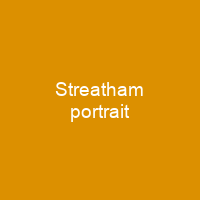The ‘Streatham’ Portrait: A Mysterious Lady in Red
Imagine stepping into a gallery, where among the countless faces staring back at you, one stands out with a story that spans centuries. This is the ‘Streatham’ portrait, an oil painting on panel believed to be a later copy of an earlier portrait of Lady Jane Grey, an English noblewoman from the 1590s.
Is this really a depiction of Lady Jane Grey? The question has intrigued art historians and enthusiasts alike. Acquired by the National Portrait Gallery in London for £100,000 in 2005 after Christopher Foley verified its authenticity, the portrait now stands as one of few known images of Lady Jane.
‘Lady Jayne’ or ‘Lady Iayne,’ the faded inscription in the upper-left corner whispers, adding a layer of mystery to this enigmatic figure. The painting measures 85.6 cm × 60.3 cm (33.7 in × 23.7 in) and is painted with oil on Baltic oak, capturing the essence of its subject with opulence and detail.
A Young Lady of Substance
The sitter is believed to be Lady Jane Grey, described as slender and pious. She wears an opulent red gown with a French hood and jewellery that indicate her high social status. Yet, instead of the expected wedding ring, she holds a prayer book—a subtle yet telling detail.
Artistic Interpretations
The painting was created in the 1590s as a copy of a woodcut from 1580, suggesting that multiple copies were made from the same original. Similar portraits exist, each offering its own interpretation of Lady Jane’s likeness.
Authenticity Debated
The authenticity of the ‘Streatham’ portrait has been a subject of debate among experts. In December 2005, Sir John Guinness showed it to Christopher Foley, who accepted its age and quality. However, historian David Starkey challenged Foley’s identifications, casting doubt on the painting’s true identity.
Libby Sheldon tested the painting’s age and found it to be contemporaneous with the rest of the painting. Dendrochronological analysis later ruled out a life portrait but didn’t exclude reproduction as an option. The National Portrait Gallery purchased the portrait in 2006 for £95,000 after nine months’ consideration.
Despite its acquisition, the portrait has received predominantly negative reception as a work of art. David Starkey claimed he wasn’t convinced it was Jane Grey, while Christopher Foley countered that the evidence supported the painting’s authenticity.
A Miniature Controversy
The Streatham portrait is considered part of the National Portrait Gallery’s primary collection and has been displayed in various exhibitions since its acquisition. However, it wasn’t just this portrait that sparked debate; another miniature thought to be Elizabeth I also faced scrutiny.
Starkey examined a miniature believed to depict Elizabeth I but Foley disputed his findings, citing the sitter’s brooch and emblem as indicative of a different subject. This further underscores the complexity surrounding these historical portraits.

The ‘Streatham’ portrait remains a fascinating piece of history, a window into the life of Lady Jane Grey and the artistry of its time. As we continue to explore and debate its authenticity, one thing is certain: this painting continues to captivate our imagination, much like the enigmatic figure it portrays.
You want to know more about Streatham portrait?
This page is based on the article Streatham portrait published in Wikipedia (retrieved on November 29, 2024) and was automatically summarized using artificial intelligence.







